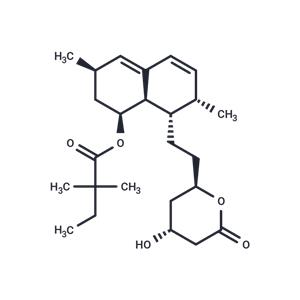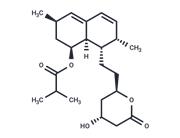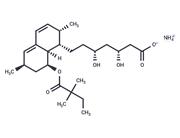| Name | Simvastatin |
| Description | Simvastatin (MK 733) is an HMG-CoA reductase inhibitor (Ki=0.2 nM) with oral activity. Simvastatin has hypolipidemic activity, inhibits hepatic production of cholesterol, and is also used for the prevention of cardiovascular disease. |
| Kinase Assay | For assessment of Akt protein kinase activity in vitro, substrate (2 μg histone H2B or 25 μg eNOS peptide) is incubated with Akt immunoprecipitated from cell lysate using goat polyclonal anti-Akt1 antibody. Kinase reactions are initiated following the addition of reaction components to a final concentration of ATP (50 μM) containing 10 μCi of 32P-γATP, dithiotreitol (1 mM), HEPES buffer (20 mM, pH 7.4), MnCl2 (10 mM), MgCl2 (10 mM). After incubation for 30 min at 30°C, phosphorylated histone H2B is visualized after SDS-PAGE (15%) and autoradiography. To estimate the extent of 32P incorporation into eNOS peptides, each reaction mixture is measured by spotting onto phosphocellulose disc filter and the amount of phosphate incorporated is measured by Cerenkov counting. The wild-type peptide sequence is 1174-RIRTQSFSLQERHLRGAVPWA-1194, and the mutant eNOS peptide is identical except that serine 1179 is substituted by alanine. |
| In vitro | METHODS: BCa cells 5637, EJ and T24 were treated with Simvastatin (0.5-40 µM) for 48 h. Cell viability was measured by MTT assay.
RESULTS: Simvastatin significantly inhibited the survival of the three BCa cells in a dose-dependent manner. [1]
METHODS: Human fibroblast SAEC and four tumor cells MCF7, HepG2, NCH, NCI were treated with Simvastatin (20 µM) for 72 h. Apoptosis was detected by TUNEL.
RESULTS: Simvastatin induced apoptosis in different types of human tumor cells, but not in SAEC cells. [2] |
| In vivo | METHODS: To study in vivo activity, Simvastatin (60 mg/kg, aqueous 2% DMSO+30% PEG 400+5% Tween 80) was administered by gavage to C57BL/6J mice once daily for six weeks on a CF diet.
RESULTS: Simvastatin treatment reduced serum cholesterol levels by 18%, and retinal cholesterol and lipoprotein cholesterol levels by 24% and 21%, respectively. [3]
METHODS: To assay antitumor activity in vivo, Simvastatin (5-50 mg/kg in methylcellulose) was administered to BALB/c nu/nu mice by gavage once daily for three days. Subsequently, colorectal cancer cells COLO205 were subcutaneously inoculated into the right side of the mice.
RESULTS: Simvastatin inhibited tumor growth in a xenograft mouse model by inducing tumor cell apoptosis and inhibiting tumor angiogenesis. [4] |
| Storage | Powder: -20°C for 3 years | In solvent: -80°C for 1 year | Shipping with blue ice/Shipping at ambient temperature. |
| Solubility Information | Ethanol : 100 mg/mL (238.91 mM), Sonication is recommended.
DMSO : 50 mg/mL (119.45 mM), Sonication is recommended.
10% DMSO+40% PEG300+5% Tween 80+45% Saline : 5 mg/mL (11.95 mM), Solution.
|
| Keywords | Simvastatin | oral activity | MK-733 | MK733 | MK0733 | MK 0733 | Mitophagy | Mitochondrial Autophagy | Inhibitor | inhibit | Huh7 | HMGCR | HMGCoAReductase | HMG-CoA Reductase (HMGCR) | HMG-CoA reductase | HMGCoA Reductase | HepG2 | Ferroptosis | cholesterol synthesis | Autophagy | Apoptosis | anti-proliferation activity | anticancer |
| Inhibitors Related | Stavudine | Aceglutamide | Urea | Cysteamine hydrochloride | Hydroxychloroquine | Metronidazole | Guanidine hydrochloride | Paeonol | Naringin | Dimethyl phthalate | Alginic acid | Dextran sulfate sodium salt (MW 5000) |
| Related Compound Libraries | Anti-Tumor Natural Product Library | Failed Clinical Trials Compound Library | Terpene Natural Product Library | Anti-Neurodegenerative Disease Compound Library | EMA Approved Drug Library | Natural Product Library | Anti-Cancer Approved Drug Library | Natural Product Library for HTS | Immunology/Inflammation Compound Library | Anti-Aging Compound Library | Bioactive Compounds Library Max | Anti-Cancer Drug Library |

 United States
United States






